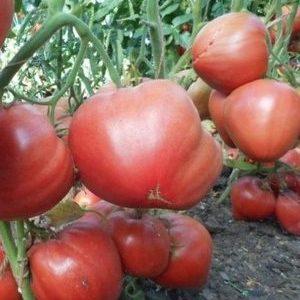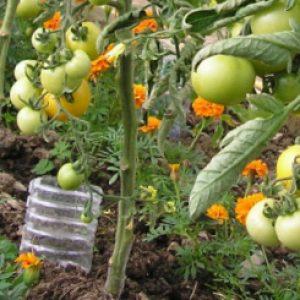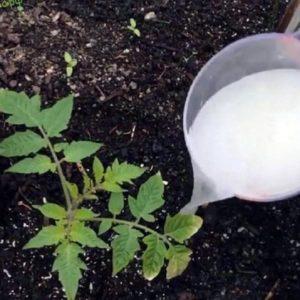How to achieve maximum yield from an Eagle Beak tomato?
Not long ago, a new tomato variety, Eagle's Beak, appeared on the windows of gardening stores. Some tomato growers have already tried to grow it and gave feedback about the variety. We have collected conclusions about the yield of tomatoes, the characteristics of their cultivation and methods of using the fruit. Let's look at everything in order.
Characteristics and description of the tomato variety
Tomatoes of the Eagle Beak variety are easily recognized by their appearance. The fruits are heart-shaped with a pointed bottom and raspberry-pink in color.
Look how they look in the photo:

The variety was bred by Russian breeders, so it is well suited to our climatic conditions. It is preferable to grow tomatoes in a greenhouse, but it is also possible in unprotected soil. The variety is mid-season. From seed germination to the first harvest, an average of 105-110 days pass.
Plants of indeterminate type. This means that they have no restrictions on the growth of the bush, reaching a height of 2 m or more.
Bushes of the Eagle Beak variety need pinching and shaping.
Fruit
The tomato variety got its name precisely because of the unusual shape of the fruit - its curve resembles an eagle's (or falcon's) beak.
The fruits are low-water, fleshy. They contain a minimal amount of seeds and a lot of dense pulp.
Tomatoes are suitable for making fresh salads. They are also used for canning, selecting small specimens. Large tomatoes are dried and frozen. They are also suitable for making ketchup, lecho and tomato sauces.
Productivity
According to reviews from gardeners, the yield of Eagle Beak tomatoes reaches 5-7 kg per bush. On the first branches, the fruits grow weighing up to 700-900 g. The average weight of the remaining fruits is 150-400 g.
Pros and cons of the variety
Gardeners emphasize the positive aspects of the Eagle Beak tomato variety:
- unusual fruit shape;
- high productivity;
- bushes are resistant to many diseases, including late blight;
- The dense skin of tomatoes can withstand long-term transportation of the crop;
- versatility of using tomatoes;
- the fruits do not crack.
Among the disadvantages of the variety, tomato growers note difficulties in caring for the bushes. They are needed:
- tie up;
- pinch;
- to form;
- feed.
How to grow
Tomatoes of the Eagle Beak variety are grown in seedlings. Seeds are sown in early March. In this case, the first harvest is obtained in mid-July.
Preparing seeds and caring for seedlings
To plant seeds, you will need a container for growing seedlings and fertile soil.
What can you plant seeds for seedlings in? Suitable:
- peat pots or other special trays made of pressed peat;
- plastic containers;
- cut plastic bottles;
- plastic bags, etc.
It is better to buy soil for planting in a specialized store, then it will not require additional fertilizing or disinfection. Garden soil is also suitable for growing seedlings. It is advisable to disinfect it with a slightly pink solution potassium permanganate.
Attention! Some gardeners, before planting seeds, calcine the soil for half an hour in the oven on a baking sheet. But this method has its opponents. They argue that high temperatures cause beneficial microorganisms to disappear from the soil along with pathogens and pests.
Before planting in the ground, it is recommended to soak planting material in a growth stimulator (for example, Epin). The seeds are embedded in the soil to a depth of 1-2 cm. After planting the seeds, the container is covered with plastic film to create a microclimate and placed in a warm place.
Shoots will appear in 4-7 days. After seed germination, the film is removed. The container is transferred to a lighted place (usually on a windowsill). Water as the top layer of soil dries with settled water. Do this carefully so as not to damage the sprouts.
When several leaves grow on the seedlings, the plants are planted - they are planted together with a small earthen lump in a separate container. The plant will live in it until transplanted to a permanent place.
Landing in the ground
 If the Eagle Beak tomato variety is grown in a greenhouse, then transplantation into the ground is done in early May. As a rule, when planting, the age of seedlings reaches 60 days. If tomatoes grow in open ground, the timing will shift until June, when the threat of night frosts has passed.
If the Eagle Beak tomato variety is grown in a greenhouse, then transplantation into the ground is done in early May. As a rule, when planting, the age of seedlings reaches 60 days. If tomatoes grow in open ground, the timing will shift until June, when the threat of night frosts has passed.
When planting between plants in a row, maintain a distance of 50 to 70 cm (depending on whether you plan to grow tomatoes in one or two stems). The gap between the rows is from 50 cm. 3-4 plants are placed per square meter.
Bush formation, tying and pinching
It is better to form a bush with 2 stems - this way you will be able to achieve better yield. When eight or nine leaves grow, the first raceme with ovaries is formed on the plant. Stepchildren interfere with the development of the bush and the fruiting, so experienced tomato growers advise removing them.
Tomatoes of the Eagle Beak variety grow tall.To prevent them from lying on the ground, it is better to tie them to a support (high rail) or secure them to the upper beams of the greenhouse using braid or twine.
Attention! To prevent plants from being pinched and being less injured when tying, gardeners advise using soft materials - textile braid or strips of rags.
Watering
Watering tomatoes as the earthen coma dries out, taking into account the air temperature and weather conditions. The fruits on the bushes grow large, so Eagle Beak tomatoes are watered a little more than other varieties of tomatoes. Usually, a generous amount of watering twice a week is sufficient.
Feeding
To get a decent harvest, Eagle Beak tomatoes should be fed regularly.
Two weeks after planting, experienced tomato growers advise feed the tomatoes under the root with an ash solution. It is prepared by boiling 1 liter of ash in 10 liters of water. Water the plants with a cooled solution of 0.5 liters per bush.
During growth and fruiting, it is advisable to feed the bushes 3-4 times with complex fertilizers for tomatoes.
Organic and mineral fertilizers are used in turn. After flowering begins, nitrogen fertilizing is stopped, otherwise the bushes will end up with green tops and not fruits.
The three lower clusters of the Eagle's Beak tomato bear fruit until September on average. If the ninth month of the year is warm, then the plant continues to grow. If September is cold, growth stops. The fruits on the last clusters are ripened after the tomatoes from the lower clusters have ripened.
To increase the sugar content and keeping quality of fruits, foliar spraying of bushes with iodine-boron solution is done. To prepare it, dilute 0.5-1 tsp in 10 liters of hot water. boric acid crystals. When the solution has cooled, add 50 drops of alcohol tincture of iodine.
Important! Spray the aboveground part of the bushes with a spray bottle in cloudy weather. In sunny times, plants can get burned.
Prevention of diseases and pests
To protect tomatoes from diseases, it is recommended that before planting, treat the soil with a solution of copper sulfate at the dosage specified in the manufacturer’s instructions for the specific drug.
For pest prevention Calendula flowers are planted in a greenhouse. Its bright scent will protect plants from unwanted guests. Spraying tomato bushes with wormwood tincture will also help. To prepare it, brew 300-350 g of wormwood in 10 liters of boiling water and leave for several days.
To consolidate the effect, the treatment is repeated after two weeks.
Reviews from gardeners
All reviews about the variety found on tomato lovers’ forums are positive:
Antonina, Samara region: “The tomatoes amazed me with their size. The largest fruit in the greenhouse is 790 g; you don’t often see such a specimen. From one fruit you can make a salad for dinner for a large family! I recommend".
Olga Vikentievna, Orel: “I liked the variety. It sets a lot of fruits and they grow large. There are 4-5 tomatoes in a bunch, all of a decent size. I will plant more."
Galina, Belgorod region: “In the greenhouse the bushes grew 170-190 cm. The pulp is dense. Those who like sweet tomatoes will like it; the fruit has a pleasant taste. There are few seeds inside the tomato. The shape is very beautiful, heart-shaped.”
Let's sum it up
The Eagle's Beak tomato variety is productive and disease resistant. From one bush you get up to 5-7 kg of high-quality sweet fruits. There are few seeds in a tomato.
The pulp of the fruits is dense and fleshy, making them suitable both for fresh consumption and for canning and other homemade preparations.Try growing tomatoes of this variety on your plot - you won’t regret it.